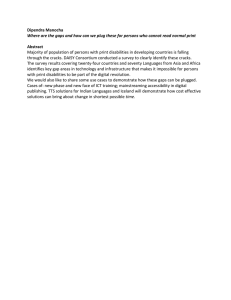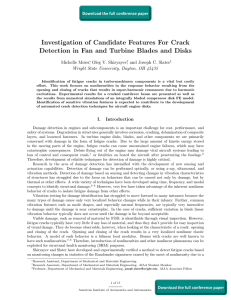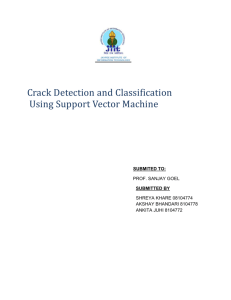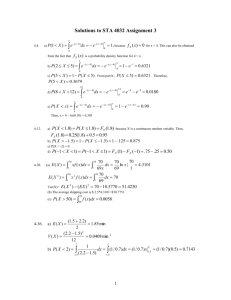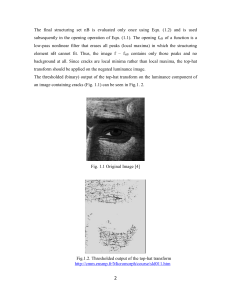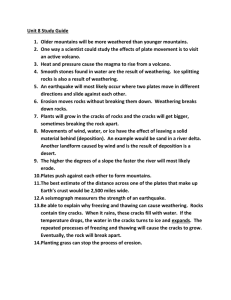International Journal of Application or Innovation in Engineering & Management... Web Site: www.ijaiem.org Email: , Volume 1, Issue 2, October 2012
advertisement
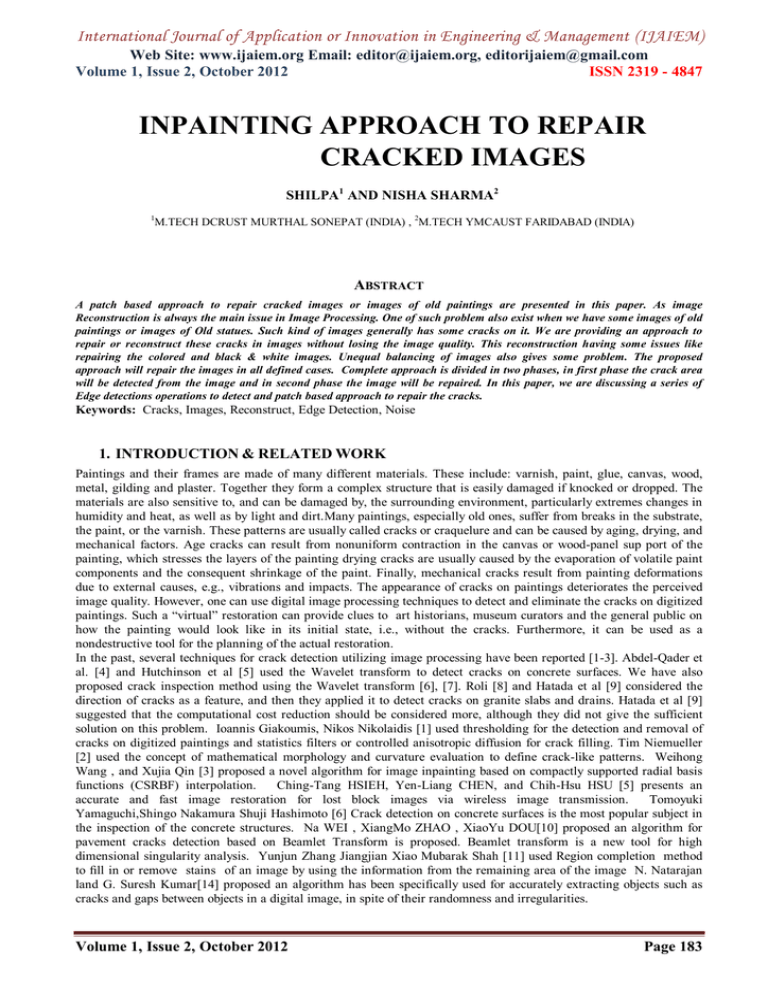
International Journal of Application or Innovation in Engineering & Management (IJAIEM) Web Site: www.ijaiem.org Email: editor@ijaiem.org, editorijaiem@gmail.com Volume 1, Issue 2, October 2012 ISSN 2319 - 4847 INPAINTING APPROACH TO REPAIR CRACKED IMAGES SHILPA1 AND NISHA SHARMA2 1 M.TECH DCRUST MURTHAL SONEPAT (INDIA) , 2M.TECH YMCAUST FARIDABAD (INDIA) ABSTRACT A patch based approach to repair cracked images or images of old paintings are presented in this paper. As image Reconstruction is always the main issue in Image Processing. One of such problem also exist when we have some images of old paintings or images of Old statues. Such kind of images generally has some cracks on it. We are providing an approach to repair or reconstruct these cracks in images without losing the image quality. This reconstruction having some issues like repairing the colored and black & white images. Unequal balancing of images also gives some problem. The proposed approach will repair the images in all defined cases. Complete approach is divided in two phases, in first phase the crack area will be detected from the image and in second phase the image will be repaired. In this paper, we are discussing a series of Edge detections operations to detect and patch based approach to repair the cracks. Keywords: Cracks, Images, Reconstruct, Edge Detection, Noise 1. INTRODUCTION & RELATED WORK Paintings and their frames are made of many different materials. These include: varnish, paint, glue, canvas, wood, metal, gilding and plaster. Together they form a complex structure that is easily damaged if knocked or dropped. The materials are also sensitive to, and can be damaged by, the surrounding environment, particularly extremes changes in humidity and heat, as well as by light and dirt.Many paintings, especially old ones, suffer from breaks in the substrate, the paint, or the varnish. These patterns are usually called cracks or craquelure and can be caused by aging, drying, and mechanical factors. Age cracks can result from nonuniform contraction in the canvas or wood-panel sup port of the painting, which stresses the layers of the painting drying cracks are usually caused by the evaporation of volatile paint components and the consequent shrinkage of the paint. Finally, mechanical cracks result from painting deformations due to external causes, e.g., vibrations and impacts. The appearance of cracks on paintings deteriorates the perceived image quality. However, one can use digital image processing techniques to detect and eliminate the cracks on digitized paintings. Such a “virtual” restoration can provide clues to art historians, museum curators and the general public on how the painting would look like in its initial state, i.e., without the cracks. Furthermore, it can be used as a nondestructive tool for the planning of the actual restoration. In the past, several techniques for crack detection utilizing image processing have been reported [1-3]. Abdel-Qader et al. [4] and Hutchinson et al [5] used the Wavelet transform to detect cracks on concrete surfaces. We have also proposed crack inspection method using the Wavelet transform [6], [7]. Roli [8] and Hatada et al [9] considered the direction of cracks as a feature, and then they applied it to detect cracks on granite slabs and drains. Hatada et al [9] suggested that the computational cost reduction should be considered more, although they did not give the sufficient solution on this problem. Ioannis Giakoumis, Nikos Nikolaidis [1] used thresholding for the detection and removal of cracks on digitized paintings and statistics filters or controlled anisotropic diffusion for crack filling. Tim Niemueller [2] used the concept of mathematical morphology and curvature evaluation to define crack-like patterns. Weihong Wang , and Xujia Qin [3] proposed a novel algorithm for image inpainting based on compactly supported radial basis functions (CSRBF) interpolation. Ching-Tang HSIEH, Yen-Liang CHEN, and Chih-Hsu HSU [5] presents an accurate and fast image restoration for lost block images via wireless image transmission. Tomoyuki Yamaguchi,Shingo Nakamura Shuji Hashimoto [6] Crack detection on concrete surfaces is the most popular subject in the inspection of the concrete structures. Na WEI , XiangMo ZHAO , XiaoYu DOU[10] proposed an algorithm for pavement cracks detection based on Beamlet Transform is proposed. Beamlet transform is a new tool for high dimensional singularity analysis. Yunjun Zhang Jiangjian Xiao Mubarak Shah [11] used Region completion method to fill in or remove stains of an image by using the information from the remaining area of the image N. Natarajan land G. Suresh Kumar[14] proposed an algorithm has been specifically used for accurately extracting objects such as cracks and gaps between objects in a digital image, in spite of their randomness and irregularities. Volume 1, Issue 2, October 2012 Page 183 International Journal of Application or Innovation in Engineering & Management (IJAIEM) Web Site: www.ijaiem.org Email: editor@ijaiem.org, editorijaiem@gmail.com Volume 1, Issue 2, October 2012 ISSN 2319 - 4847 Huaming Liu, Weilan Wang, and Xuehui Bi[13] construct an actual system of image inpainting based on the image inpainting system model in order to repair more types, more broken images in the different field and restore them more efficiently Ching-Tang HSIEH, Yen-Liang CHEN, and Chih-Hsu HSU [12] presented an accurate and fast image restoration for lost block images via wireless image transmission. we reconstruct the lost block on the wavelet domain that considers the relation between the lost block and its neighbour coefficients. M. Bertalmio, G. Sapiro, V. Caselles, and C. Ballester presented techniques for object removal and image retouching[15].M.Ashikhmin[16] presemted algorithm for removing large objects from images using texture synthesis and inpainting method to fill in image gaps .Finally three basic techniques for image reconstruction have been combined altogether in variational model to provide a working algorithm for image inpainting. 2. PROBLEM FORMULATION Image reconstruction has always a main issue in image processing. Old paintings usually suffer from cracks. These cracks may occur due to various reasons. Many materials are used altogether to make paintings like varnish, paint, glue, canvas, wood, metal, gilding and plaster. The surrounding environment affects the material of paintings. Several different reasons may contribute to formation of cracks like aging, drying, mechanical changes. Extreme changes in environmental factors like humidity and heat may leads to formation of cracks in paintings. Contraction in canvas, evaporation of volatile paint components or shrinkage in paint may also leads to appearance of cracks in paintings. Moreover, External causes like vibrations and impacts may cause painting deformations known as mechanical cracks. The detection of cracks in painting and images is not a complexly new work to do there is already work performed on this problem by using other approaches. As we know the Image Processing includes the concept of image repairing and image enhancement. This repairing and image enhancement can be performed in terms of series of filters. There are different statistical and mathematical models to work with images. We can perform the image enhancement by using different filters and as well as different sequence of the filters. In same way some work is already done by using different filters and approaches. The existing approach also divide the complete process of crack repairing in two stages. One for Detecting the Cracks and other is remove these cracks. A simple interactive approach for the separation of cracks from brush strokes is to apply a region growing algorithm on the thresholded output of the top-hat transform, starting from pixels on the actual cracks. The pixels are chosen by the user in an interactive mode. At least one pixel per connected crack element should be chosen. Alternatively, the user can choose to apply the technique on the brush strokes, if this is more convenient. Fig 1. Existing approach After identifying cracks and separating misclassified brush strokes, the final task is to restore the image using local image information (i.e., information from neighboring pixels) to fill the cracks. Two classes of techniques, utilizing Volume 1, Issue 2, October 2012 Page 184 International Journal of Application or Innovation in Engineering & Management (IJAIEM) Web Site: www.ijaiem.org Email: editor@ijaiem.org, editorijaiem@gmail.com Volume 1, Issue 2, October 2012 ISSN 2319 - 4847 order statistics filtering and anisotropic diffusion are proposed for this purpose. Both are implemented independently and affect only those pixels which belong to cracks. Therefore, provided that the identified crack pixels are indeed crack pixels, the filling procedure does not affect the “useful” content of the image. Image inpainting techniques can also be used for crack filling. Existing approach is not very efficient in detecting cracks located on very dark image areas, since in these areas the intensity of cracked pixels is very close to the intensity of the surrounding region. Selecting a low threshold value and then apply the crack-detection algorithm on the dark image area may resolve this problem. Existing approach also do not work for crack that lies in regions of different color at the same time. So, filling of such cracks may lead to a situation, where crack from one area is filled with the color that should be filled in the crack of another area. Fig 2: picture showing cracks that crosses border of different color. 3. PROPOSED SYSTEM A patch based approach has been employed for the removal of cracks from digitized paintings. For this we have to perform some image operations or the filters to resolve the problem. We are expected to use some model to handle each stage individually. Under the lifecycle of Image processing the image is already acquired and we are just presenting the raw paint image. Next to detect the Cracks we have to process. A crack can be type of edge that is abnormally dark and highlighted then the other image areas. It gives the look as of the edge, we are trying to implement the edge based filtering tools to get the enhanced image the expected algorithm to detect the crack or to perform edge detection is given as: Edge detection is most common approach for detecting meaningful discontinuities in gray level. The magnitude of first derivative can be used to detect the presence of an edge at a point in the image. The sign of second derivative can be used to determine whether an edge pixel lies on the dark or light side of an edge. Different Operators used for Edge detection Prewitt operator -1 -1 -1 0 0 0 1 1 1 Prewitt operator -1 -1 -1 0 0 0 1 1 1 For detecting diagonal edges 0 1 2 -2 -1 -1 0 1 -1 0 -2 -1 0 0 1 0 1 2 ALGORITHM: Step1: Load image. Step2: Take the size of image as m*n. Step3: Run the first mask on the image. Step4: Run the second mask on the image. Step5: Add the output of both masks. Step6: Display the output. Volume 1, Issue 2, October 2012 Page 185 International Journal of Application or Innovation in Engineering & Management (IJAIEM) Web Site: www.ijaiem.org Email: editor@ijaiem.org, editorijaiem@gmail.com Volume 1, Issue 2, October 2012 ISSN 2319 - 4847 Canny filter have been used for edge detection because it results in better line drawing of an image and provide better results. Once the cracks detected the next work is to represent the area where these cracks are present. Now a manual input is required. A patch will be provided manually just to recognize the working area. Once the area found the next work is to fill the cracks, to fill these we have to gather information pixels from surrounding pixels. For example we can take a matrix of 16x16 and find the average pixel value and replace the crack position pixel values by this new value it will replace the cracks. An algorithm used in this paper is presented next: 1. Find all boundary point of cracked portion 2. Find data pattern & confident for each boundary point 3. Multiply data pattern & confident of each Boundary point (It is total point/strength/priority of particular pixel) 4. Find the pixel on boundary point which one having highest priority 5. Create patch window by keeping that highest priority pixel as central one 6. Match this window with entire image from (0,0)th pixel to (x,y)th pixel and identify the matched window. 7. Collect all the matched window position and again find data pattern & confident for each matched window, and multiply data pattern & confident 8. Find highest priority matched window then replace the patch window, which has been created in point number (5), with currently got matched window 9. Repeat the above steps unless there is no further inpainting needed. 4. RESULTS This chapter shows the output of work done .Results that comes out after applying our approach. This section shows the output in terms of screen shots taken. It shows the stepwise process via screen shots. Starting from acquired image, its feature detection, progress in image repairing after different time intervals and final repaired image. PSNR(peak signal to noise ratio) value for the repaired image to show the quality of repaired image. MSE (Mean Square Error ) value has also been depicted through command window. Histograms has also been shown for both original and repaired image. This approach can be used for both black & white images as well as colored images. Firstly in result section output with black and white images is shown and then same approach is used for color images. Result for colored images follow the output for black and white images. Screen shot for original image used for this work Fig 3: original image used Fig 5: edge detection using canny filter Volume 1, Issue 2, October 2012 Fig 4: feature extraction for the original image Fi g 6: i m a ge a ft er 250 i t er a t i on s Page 186 International Journal of Application or Innovation in Engineering & Management (IJAIEM) Web Site: www.ijaiem.org Email: editor@ijaiem.org, editorijaiem@gmail.com Volume 1, Issue 2, October 2012 ISSN 2319 - 4847 Fi g 7: i m a ge a ft er 750 i t er a t i on s Fi g 8: i m a ge a ft er 1500 i t er a t i on s Fi g 9: i m a ge a ft er 2500 i t er a t i on s Fig 10: Showing final repaired image. Fig 11: histogram for original image. Fig 12: Histogram for repaired image. Fig 13: PSNR and MSE values for repaired image Fig 14: Time taken for different no. of iterations. For colored images Fig 15: repaired colored image with this approach Volume 1, Issue 2, October 2012 Fig 16: histogram for the original image Page 187 International Journal of Application or Innovation in Engineering & Management (IJAIEM) Web Site: www.ijaiem.org Email: editor@ijaiem.org, editorijaiem@gmail.com Volume 1, Issue 2, October 2012 ISSN 2319 - 4847 Fig 17: histogram for the repaired image 5. CONCLUSION This Research work is mainly to develop some method where we can remove the cracks from some old paintings and the digitized images. We have to first identify the cracks and then fill them by the using patch based approach and then perform the smoothing. This is some kind of Image processing with retouching or we can say repairing the images. we have defined an efficient patch based work to remove the scratches for the cracks from the images for old paintings. We have defined area specific work, it means instead of working with whole image we work with cracked area because of the selected area in image. The proposed work is efficient than other image restoration processes. Thus proposed work is an application of image restoration for image repairing. It can be used to remove smaller non linear objects, cracks for other patched from the image. We represent the work in iteration specific way, it means we can control the quality; it will work for all types of images including JPEG, GIF and BMP etc. 6. FUTURE WORK We can extend this work in case of object identification in still images as well as video, as the defined work is the identification of small objects, patches and cracks in images, we can use same concept to identify large objects in images for videos. REFERENCES [1] Ioannis Giakoumis, Nikos Nikolaidis, “Digital Image Processing Techniques for the Detection and Removal of Cracks in Digitized Paintings” ieee transactions on image processing,vol. 15 , no. 1 janruary 2006,pp 178-188. [2] Tim Niemueller “Automatic Detection and Segmentation of Cracks in Underground Pipeline Images”, gnu Free Documentation License ,2006, pp 1-27. [3] Weihong Wang , and Xujia Qin, “An Image Inpainting Algorithm Based on CSRBF Interpolation” , International Journal of Information Technology Vol. 12 No. 6 2006, pp 112-119. [4] I. Abdel-Qader, O. Abudayyeh and M.E. Kelly, “Analysis of Edge Detection Techniques for Crack Identification in Bridges,” Journal of Computing in Civil Engineering, American Society of Civil Engineers, vol.17, no.3, pp.255-263, 2003. [5] T.C. Hutchinson and Z. Chen, “Improved Image Analysis for Evaluating Concrete Damage,” Journal of Computing in CivilEngineering, American Society of Civil Engineers, vol.20, no.3, pp.210-216, 2006. [6] Tomoyuki Yamaguchi Shingo Nakamura Shuji Hashimoto,” An Efficient Crack Detection Method Using Percolation-Based Image Processing”, 978-1-4244-1718-6/08/$25.00 ©2008 IEEE, pp 1875-1880. [7] Chen Yuchao#1, Liu Hui*,Nanyang, China, 473061,” Study on the Meso-Structure Image of Shale Based on the Digital Image Processing Technique”, 978-1-4244-3986-7/09/$25.00 ©2009 IEEE,pp 1-4. [8] F. Roli, “Measure of texture anisotropy for crack detection onmtextured surfaces,” ELECTRONICS LETTERS, vol.32, no.14 pp.1274-1275, 1996. [9] T. Hatada, F. Saitoh, “Crack detection method for drain by using directional smoothing”, IEEJ Trans. EIS, vol.127, no.2, pp.241-246, 2007. [10] Na WEI , XiangMo ZHAO , XiaoYu DOU,” Beamlet Transform Based Pavement Image Crack detection”, 2010 International Conference on Intelligent Computation Technology and Automation, pp 1-3. [11] Yunjun Zhang Jiangjian Xiao Mubarak Shah,” Region Completion in a Single Image”, EUROGRAPHICS 2007, pp 1-4. [12] Ching-Tang HSIEH, Yen-Liang CHEN, and Chih-Hsu HSU, “Fast Image Restoration using the Multi-Layer Best Neighborhood Matching Approach” Proceedings of the 6th WSEAS International Conference on Applied Computer Science, Hangzhou, China, April 15-17, 2007,pp 441-446. [13] Huaming Liu, Weilan Wang, and Xuehui Bi, “Study Of Image Inpainting Based On Learning”IMECS 2010,march 17-19,2010, pp 1-4. Volume 1, Issue 2, October 2012 Page 188 International Journal of Application or Innovation in Engineering & Management (IJAIEM) Web Site: www.ijaiem.org Email: editor@ijaiem.org, editorijaiem@gmail.com Volume 1, Issue 2, October 2012 ISSN 2319 - 4847 [14] N. Natarajan1*, P. Seetal2 and G. Suresh Kumar1,” Robust Image Segmentation Based on Optimal Thresholding”, ISSN 0975- 6469 Volume 2, Number 2 (2010), pp. 135–144. [15] M. Bertalmio, G. Sapiro, V. Caselles, and C. Ballester, “Image inpainting,” Computer Graphic (SIGGRAPH 2000), pp. 417–424, July 2000. [16] M. Ashikhmin, “Synthesizing natural textures,” ACM Symposium on Interactive 3D Graphics, pp. 217–226, 2001 Volume 1, Issue 2, October 2012 Page 189
